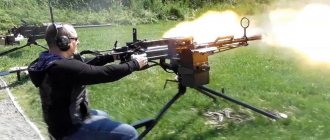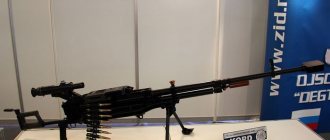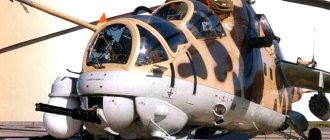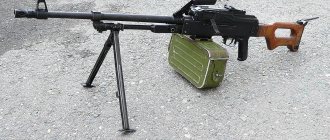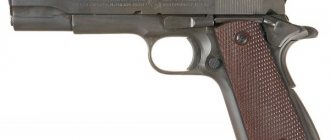Cartridge .50 Browning / 12.7×99
| .50 Browning |
The 12.7×99 caliber cartridge is designated: .50 Browning / .50 BMG / .50 Browning Machine Gun / .50 US Gvt. / 12.7×99 / 12.7 mm Browning / 12.7 mm M 1947 / 12.7 mm Patrone 48 / 50 Browning MG 1919 / SAA 9340 / XCR 13 099 BGC 030.
.50 Browning
In 1918, the Americans conducted extensive research into the selection of a new .50 caliber cartridge that was to be used in an anti-tank rifle and an aircraft machine gun. Flanged and wafer-free chucks of various shapes were tested. As a result, the experts settled on the cartridge recommended by J. Browning and Winchester.
The .50 Browning cartridge, developed by the famous American designer John Moses Browning, was intended for the 0.5-inch (.50) M2 Browning machine gun.
The 12.7x99mm cartridge is a larger version of the .30-06 Springfield rifle cartridge used in the 7.62mm M1917 machine gun. It consists of a brass or steel beltless bottle-shaped sleeve, a Boxer-type capsule, a powder propellant charge and a bullet. The maximum bullet diameter is 12.96 mm / 12.98 mm (.510 / .511).
In 1919, Colt factories produced a new machine gun chambered for this cartridge.
Officially, the first sample of the .50 Browning cartridge was accepted for supply to the US Army in 1923.
Together with Browning machine guns, the .50 Browning cartridge very quickly gained well-deserved popularity among the troops, which has not waned to this day.
During World War II, the cartridge was supplied to all countries of the allied alliance and was used mainly in aircraft machine guns.
The cartridge was also supplied to the USSR as ammunition for Lend-Lease armored vehicles and aircraft (as were other types of cartridges).
After World War II, the .50 BMG cartridge spread throughout the world (except in the Warsaw Pact countries) as the standard NATO large-caliber infantry machine gun ammunition, and today is produced by more than 30 manufacturers to American standards and is therefore interchangeable.
The .50 Browning cartridge has also become widespread in long-range sniper rifles designed to hit targets at a distance of up to 1500 meters, the number of samples of which is increasing every year. The largest number of rifles for the 12.7×99 caliber are produced by McMillan and Harris.
Currently, the .50 Browning cartridge is produced with steel and brass cases. It is equipped with bullets of various types for military purposes, the main ones being ordinary, tracer and armor-piercing. For example, the M2 ammunition is produced for the US Army with a spindle-shaped pointed bullet with a steel core weighing 46.79 g, an initial speed of 857 m/s and a muzzle energy of 17149 J.
From left to right .50 Browning Armor-Piercing M2 (Brazil) .50 Browning Armor-Piercing-Incendiary (Dominican Republic) .50 Browning Armor-Piercing (Dominican Republic) .50 Browning Armor-Piercing-Incendiary-Tracer (Dominican Republic) . 50 Browning Armor-Piercing-Tracer (Dominican Republic) .50 Browning Ball M33 (Greece) .50 Browning Ball M33 Sniper Quality (Israel) .50 Browning Armor-Piercing-Incendiary M8 (Israel) .50 Browning Armor-Piercing-Incendiary- Tracer M20 (Israel)
Most of the bullets produced in the world today for the .50 BMG cartridge are modeled after the American bullets used during World War II: - regular M2, - armor-piercing M2, - tracer M1, - incendiary M1, - armor-piercing incendiary M8 ;
as well as those adopted for service in the post-war years: - conventional MZZ, - tracer M10 and M17, - incendiary M23, - armor-piercing incendiary-tracer M20.
A regular M2 bullet has a tombac shell filled with lead at the head and a steel core.
A regular MZZ bullet differs from the M2 only in that the core is covered at the back with a sealing washer.
The design of the M2 armor-piercing bullet is close to the design of the conventional M2, but instead of a steel core, an armor-piercing one is used, which from a distance of 500 m can penetrate a steel sheet 19 mm thick.
The M8 armor-piercing incendiary bullet is similar to the M2 armor-piercing bullet, the head part of the shell is filled with an incendiary mass.
In the United States, the .50 Browning cartridge is often used in target shooting. In Europe, this process is not so intense, which is due to the lack of civilian shooting ranges of sufficient size.
Since bulk machine-gun ammunition could not provide acceptable accuracy of fire, it was initially recommended to use cartridges from the Norwegian Raufoss Arsenal plant for rifles, which had better characteristics. But soon other manufacturers (for example, the American company PMC-ammo) began to produce cartridges more or less suitable for sniper shooting.
Standard types of .50 Browning cartridge:
Left - Right .50 Browning Ball M33 (K) (UK) .50 Browning Tracer M17 (K) (UK) .50 Browning Armor-Piercing W Mark 1z (UK) .50 Browning Armor-Piercing M2 (K) (UK) .50 Browning Incendiary M1 (K) (UK) .50 Browning Dark-Ignition-Incendiary-Tracer (UK) .50 Browning Ranging-Observing L11A2 (UK)
UK: - general purpose Mk 3Z - spindle-shaped pointed bullet with steel core, weight 46.01 g, initial speed - 823 m/s; - GMk 6Z tracer - a pointed bullet with a flat bottom, with a lead tip, weighing 44.39 g, initial speed - 832 m/s; — incendiary VMk 2Z — a pointed bullet with a flat bottom and a steel jacket, 46.01 g, initial speed — 793 m/s; - armor-piercing, incendiary Mk 1Z - spindle-shaped pointed bullet with a steel core, weighing 42.77 g, initial speed - 870 m/s; - sighting L11A1 - spindle-shaped pointed bullet with a steel core, weighing 40.56 g, initial speed - 914 m/s; - sighting L11A2 - spindle-shaped pointed bullet with a steel core, weighing 40.56 g, initial speed - 903 m/s; - sighting L13A1 - spindle-shaped pointed bullet with a steel core, weighing 62.53 g.
From left to right .50 Browning Armor-Piercing-Incendiary M8 (K) (UK) .50 Browning Armor-Piercing-Incendiary-Tracer M20 (K) (UK) .50 Browning Armor-Piercing-Incendiary-Hard Core (UK) . 50 Browning Proof L12A1 (UK) .50 Browning Dummy L1A1 (UK) .50 Browning Dummy L1A1 (UK) .50 Browning Dummy U Mark 1 (UK) .50 Browning Dummy (UK)
USA: - general purpose M2 - spindle-shaped pointed bullet with a steel core, weight 46.01/46.79 g, initial speed - 858 m/s; - general purpose MZZ - spindle-shaped pointed bullet with a steel core, weighing 42.9 g, initial speed - 888 m/s; - armor-piercing M2 - spindle-shaped pointed bullet with a steel core, weighing 45.88 / 46.53 g, initial speed - 885 m/s; - M10 tracer - a pointed bullet with a flat bottom and a lead tip, weighing 41.67 g, initial speed - 873 m/s; - M17 tracer - a pointed bullet with a flat bottom and a lead tip, weighing 41.67 g, initial speed - 873 m/s; - M21 tracer - a pointed bullet with a flat bottom and a lead tip, weighing 45.3 g, initial speed - 867 m/s; - armor-piercing incendiary M8 - spindle-shaped pointed bullet with a steel core weighing 42.06 g, initial speed - 888 m/s; - armor-piercing incendiary tracer M20 - a spindle-shaped pointed bullet with a steel core, weighing 39.66 g, initial speed - 888 m/s; — incendiary M1 — a spindle-shaped pointed bullet with a steel jacket, weighing 41.02 g, initial speed — 901 m/s; - incendiary M23 - a pointed bullet with a flat bottom, weighing 33.18 g, initial speed -1036 m/s.
Belgium (FN): - general purpose MZZ - bullet weighing 43 g, initial speed - 910 m/s; - tracer M17 - bullet weighing 41.7 g, initial speed - 910 m/s; - armor-piercing (armor-piercing incendiary) M8 - bullet weighing 43 g, initial speed - 910 m/s; - armor-piercing, incendiary, tracer M20 - bullet weighing 40.4 g, initial speed - 910 m/s; - armor-piercing incendiary M160 - explosive bullet with a heavy core, weighing 43 g, speed - 890 m/s, muzzle energy - 17030 J.
From left to right .50 Browning Ball M33 (USA) .50 Browning Tracer M1 (USA) .50 Browning Armor-Piercing M1 (USA) .50 Browning Armor-Piercing M2 (USA) .50 Browning SLAP (USA) .50 Browning Incendiary M1 (USA) .50 Browning Armor-Piercing-Incendiary M8 (USA) .50 Browning Armor-Piercing-Incendiary-Tracer M20 (USA) .50 Browning Test, High Pressure Test M1 (USA) South Africa (“
Armscor”): — general purpose - bullet weighing 45 g, initial speed - 823 m/s; - tracer - bullet weighing 43.7 g, initial speed - 823 m/s; armor-piercing incendiary - bullet weighing 41.18 g, initial speed - 868 m/s.
Great Britain (“Eley-Kynoch”): - general purpose M2 - spindle-shaped pointed bullet with a steel core, weighing 46.01/46.79 g, initial speed - 858 m/s; - general purpose MZZ - spindle-shaped pointed bullet with a steel core, weighing 42.9 g, initial speed - 888 m/s; - armor-piercing M2 - spindle-shaped pointed bullet with a steel core, weighing 45.88/46.53 g, initial speed - 885 m/s; - M10 tracer - a pointed bullet with a flat bottom and a lead tip, weighing 41.67 g, initial speed - 873 m/s; - M17 tracer - a pointed bullet with a flat bottom and a lead tip, weighing 41.67 g, initial speed - 873 m/s;
- M21 tracer - a pointed bullet with a flat bottom and a lead tip, weighing 45.3 g, initial speed - 867 m/s; - armor-piercing incendiary M8 - spindle-shaped pointed bullet with a steel core weighing 42.06 g, initial speed - 888 m/s; - armor-piercing incendiary tracer M20 - a spindle-shaped pointed bullet with a steel core, weighing 39.66 g, initial speed - 888 m/s; - incendiary M1 - a spindle-shaped pointed bullet with a steel jacket, weighing 41.02 g, initial speed - 901 m/s; - incendiary M23 - a pointed bullet with a flat bottom, weighing 33.18 g, initial speed -1036 m/s.
Colt-Browning heavy machine gun
In 1889, John Browning developed an easel machine gun with a barrel cooling system and removal of powder gases. After which, the rights were purchased, which already in 1895 released the Colt M1895 machine gun. Thanks to serial production, the product was sold to European countries and a number of Latin American countries. At the dawn of the First World War, a modification with a weighted barrel was released. Russia purchased this machine gun in huge quantities, the weapon was popular along with the Maxim machine gun.
Machine gun sniper shooting
This is the first time such a machine gun has been used in the Korean War. However, the Browning machine gun gained the greatest popularity during the Vietnam War, when one of the US snipers named Carlos Hatchcock hit several times a target no larger than a human figure located at a distance of about 1700 meters. At first, the rumor about such a shooting that spread around the US troops played into their hands and raised their morale. A commission was even formed that tested this shooter to set and register a world record. Information about Carlos's sniper shooting with a machine gun was confirmed.
The machine guns fired from the machine were even equipped with a sniper scope after such an incident. There is only one caveat. In fact, no one used this sight, and the Browning machine gun itself was used for its intended purpose. Well, there are not so many unique people in the army who will universally use a machine gun as a sniper rifle.
But the idea of creating a sniper rifle based on the design of a machine gun attracted attention and was developed. But not for long. As a result, the project to create a sniper rifle was curtailed, and in 1982 it appeared on the scene with its sniper rifles, which quickly entered service with the US Army and the Browning sniper initiative was safely forgotten.
The myth about sniper shooting with a machine gun lasted until about 2002, gradually acquiring new details and fables. Passing from mouth to mouth, data on the firing range of the “sniper” was constantly changing. In 2002, news was recorded about a firing range of up to 3000 meters, which immediately revealed the outright delusion of the material being presented.
TTX M2
The legendary machine gun weighs 38 kg, and if with a machine gun, then it is much more - 58 kg.
The length of the product is 1653 mm, of which the barrel is 1143.
Uses the NATO cartridge 12.7 x 99 mm.
The military version of the machine gun (the one that was installed on the tank) has a rate of fire that varies from 483 to 630 rounds per minute. The AN/M2 aircraft machine gun has slightly different indicators - from 740 to 845.
The upgraded version of the aircraft gun (AN/M3) has a rate of fire of 1200 rounds per minute.
The sighting range is 1820 meters.
Since mass production began in 1921, over 3 million products have been produced.
Performance characteristics
The Browning-M1919 machine gun served until 1970, but gradually began to remove this model from service by the end of 1945 due to an analysis of combat operations in general, which showed that the machine gun was obsolete, and emerging models (including in other countries ) push the product, according to its characteristics, to the second (or even third) plan.
The Browning light machine gun weighed 14 kg, length 1219 millimeters, of which the barrel was 609 mm. Rate of fire from 400 to 600 rounds per minute based on the principle of recoil of the barrel at a short stroke with lever locking.
Power was supplied by a machine gun belt with 250 rounds of ammunition at a maximum sighting range of 1,369 meters.
Browning M2 heavy machine gun
As mentioned above, it gained the greatest popularity thanks to its installation on heavy equipment and use as an anti-aircraft gun. Represents mo
But in most cases, it was still used as a means of suppressing enemy manpower. The M46 tank often carried a heavy-caliber Browning machine gun mounted on its armor. But when firing from the armor, the crew member had to lean out of the hatch approximately waist-deep, which made the soldier vulnerable. Therefore, a second machine gun was mounted, and the standard machine gun provided on the M46 was replaced with a Browning machine gun. Thus, the firepower of the combat vehicle increased significantly.
But such modernization was carried out not at the plant that produced the equipment, but directly by the crew of the combat vehicle itself in combat conditions, which had a very significant impact on the need to replenish ammunition for the Browning machine gun (12.7 mm M2).
The American Browning machine gun (M2) is designed for belt feeding, and the 550-round box intended for standard weapons on the M46 was often not enough. Therefore, the crew had to wriggle out on their own to solve this difficult task.
